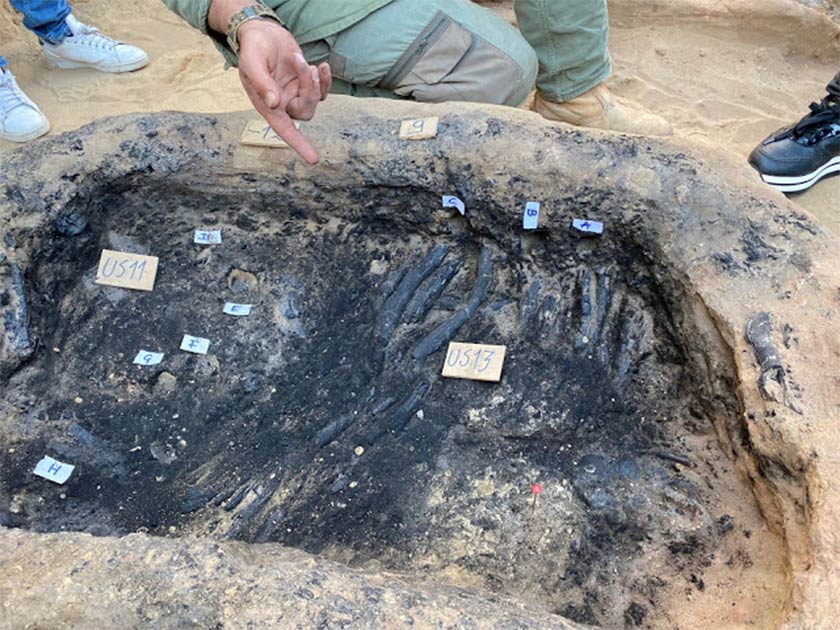Evidence of Deceased Baby Burning Discovered in Sicily
The remains of what appears to have been a unique funeral ceremony and Greek burial have been discovered at the ancient colony of Gela in southern Sicily. Founded some time between 689 and 688 BC, the Greek colony is located on the Mediterranean Gulf of Gela. The archaeological Mecca includes a temple of Athena which dates back to the 5th century BC and the Acropolis.
Over time, archaeologists at this archaeological site have unearthed vast amounts of painted terracotta, often from jars which once held the cremated remains of ancient people. This latest discovery comprises “a small skull and a small horn-shaped pendant.” The remains of this Greek child burial were left behind after a demolition was performed to make way for a new building on the Federico II promenade only a few hundred meters from the Bosco Littorio archaeological area, known for its Archaic Age emporium.
Archaeologist Daniela Vullo of the Archaeological Museum Caltanissetta, along with the Museum’s archaeological director Carla Guzzone, told Archaeology News Network that their colleague Gianluca Calà was excavating beneath a layer dating to the 7th century BC when “three earthen structures” containing a layer of ash, charred wood and fragments of human bones, that date to the eighth century BC” were found.

Archaeologists at the dig site on the island of Sicily where the Greek burial was discovered. (Superintendence of Caltanissetta)
A Tangible Death Ritual from Ancient Literature
One of the Greek burials held the remains of at least one adult and another is still being excavated. The third one held the small skull and a small horn-shaped pendant amongst the ashes. The researchers have now determined that the skull belonged to a baby of only a few months old. It appears the wooden structure was the infant´s funeral wooden pyre.
- Unusual Greek Baby Burial Unearthed in Sicily
- 8,000-Year-Old Child Remains Discovered With No Limbs
- Experts Still Stumped By Child Buried With A Bird In Its Mouth
The archaeologists say the “uniqueness” of this discovery lies in the importance of the ancient funerary ceremony that was intended “to purify the soul of the deceased child for its trip to the kingdom of Hades,” named after the ancient Greek god of the dead. This specific ritual is described in Homer’s Iliad in the funeral ceremony of the heroes.
The researchers say it is “thanks to the wealth of details concerning the funeral ceremony of Patroclus that we know that the funeral for the ancient Greeks was a very important moment for relatives and crucial for the deceased.” Now, archaeologists have actual evidence of someone who had been subjected to this ancient Greek death ritual.

New evidence of ancient Greek burial ritual practices has been uncovered in Sicily. (Superintendence of Caltanissetta)
Three Steps for a Safe Passage to Hades
Further highlighting the importance of this burning ceremony, the researchers say it was performed specifically for the “salvation” of the deceased's soul while transiting from here to the world of the dead. And this transitory process of the soul could only occur if each of the three principal steps of the ceremony were conducted properly in accordance with ancient Greek burial tradition.
The finding of the ancient Greek infant remains at Gela represent the last of the three steps of the funerary ritual. Firstly, the deceased's body was washed to the soundtrack of “the lamentations of the women” and after being adequately prepared, a grand feast was held in memory of the deceased. Then, a procession of people marched the deceased body through the city to the location of the prepared funeral pyre.
After the ceremonial fire died down the remainder of the ash and bones were collected and stored in a funerary container. This container was then transported to the tomb where it was planned to remain undisturbed forever, or at least as long as it takes for archaeologists to get their hands on it. The researchers conclude that each of these steps had to follow “strict canons of tradition, or the deceased would not have reached Hades and would have remained wandering in the form of an evil spirit.”
If, as the researchers expect, this deceased baby’s charred remains are indeed confirmed as being from the 8th century BC, then this discovery represents the “oldest cremation site in the Greek history of Gela.” And the first evidence of a death ritual within the immortal story of Greek tragedies.
Top image: The remains of what appears to have been a unique funeral ceremony and Greek burial have been discovered at the ancient colony of Gela in southern Sicily. Source: Superintendence of Caltanissetta
By Ashley Cowie



















